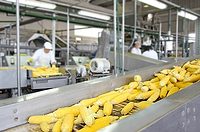Sanitary design in produce processing plants: How to get started

Product recalls appear in headlines almost daily and make food safety a top public concern. Plus, the regulatory changes of the Food Safety Modernization Act (FSMA) are not only daunting, but they’ve increased requirements for produce processors. Upgrades to procedures and equipment can help processors comply with the new standards and reduce risk.
The protein industry has been aware of the importance of sanitary design for more than 15 years, since the North American Meat Institute developed best practices to improve food safety. The “10 Principles of Sanitary Design” laid out the key concepts for establishing a sanitary processing plant, and is still followed today. Although created with protein processors in mind, these principles are applicable to produce processors and other food manufacturers too.
Produce processors, like all food processors, have a responsibility to continually learn, innovate and update facilities and processes to ensure food safety. That’s no easy task. Before getting discouraged, or jumping in full force, consider how you’d benefit from taking the time to properly develop and implement effective sanitary design throughout your facility.
Effective sanitary design, helps produce processors create an environment that mitigates food safety risks, and when coupled with a robust sanitation program prevents potential foodborne illness outbreaks, including Listeria, Salmonella and E. coli. Big picture, it helps protect a brand’s reputation and avoid the costly impact of a failed inspection or recall.
Now is the time to be proactive in sanitary design. And, while implementing sanitary design can feel like a daunting task, there are a few ways produce processors can begin.
1. Tap the expertise of trusted partners.
Encourage your internal sanitation team to work collaboratively with equipment manufacturers, chemical suppliers, sanitation companies and even other food companies to implement your sanitation plan.
2. Review your budget.
While spending on equipment and facility upgrades can be a large investment, the payoff down the road is significant because you’ll avoid costly recalls or FSMA violations. Sanitary design costs money, yet a lack of sanitary design can cost more, even your brand’s reputation.
3. Bring in a food safety expert.
Consider partnering with an outside source that understands FSMA, is preventive controls qualified, knowledgeable about produce processing and has a track record of implementing effective sanitary design. Their insight, along with your commitment to sanitary design, can reduce the likelihood of an outbreak, recall or other food safety risks.
FSMA is being implemented. Costs of a recall are significant. Brand reputation damage can last years. Even criminal liability is on the table with the FDA and the Department of Justice. A higher level of commitment to food safety including sanitary design of processing facilities is vital.
Sanitary design for equipment and facilities is an important part of a multi-faceted approach to food safety and essential for all processors. Thankfully, the right produce and fresh cut safety specialists are available to help you get started.
Looking for a reprint of this article?
From high-res PDFs to custom plaques, order your copy today!









